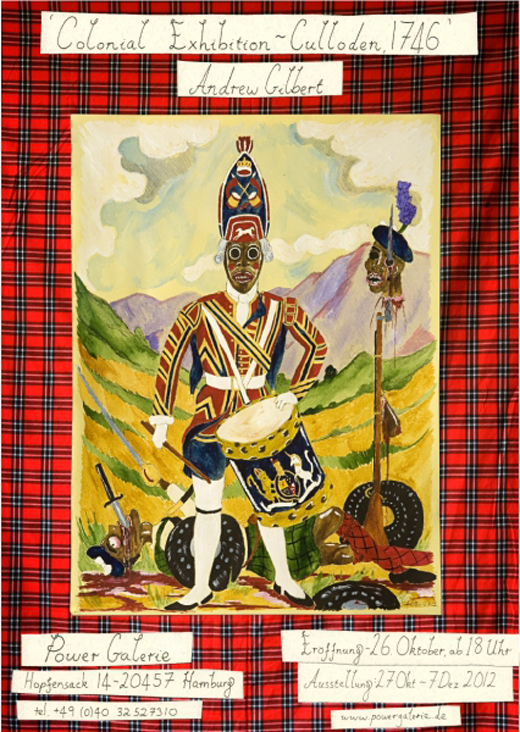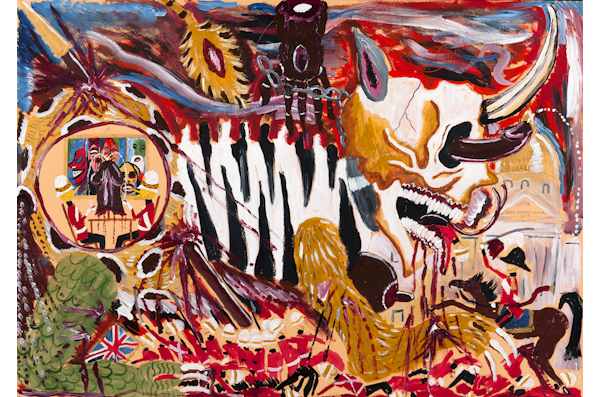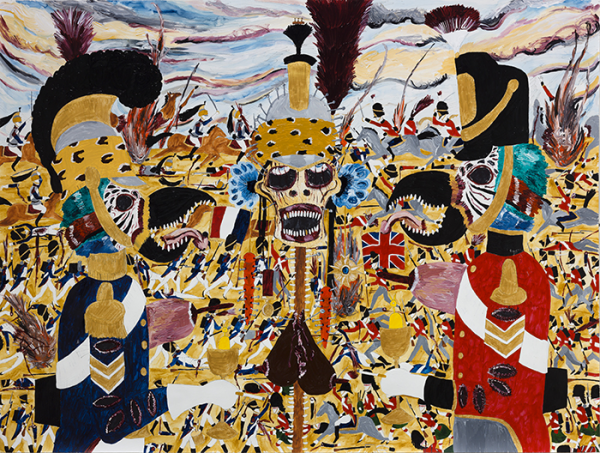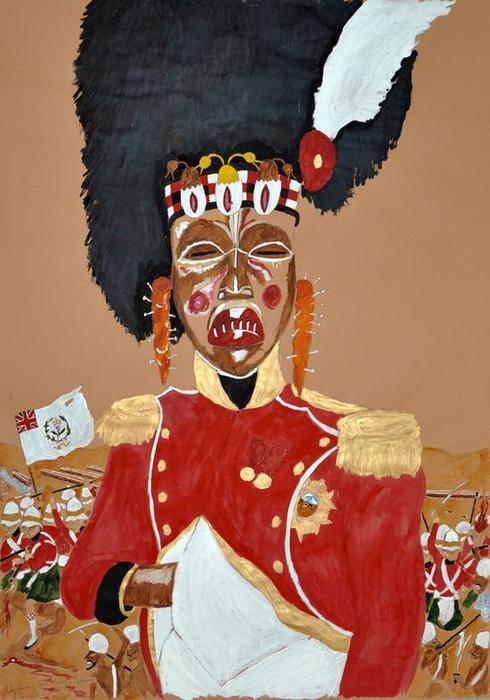
Andrew Gilbert
Trophies of the Savages – Idols of Civilisation
Blank Projects, 113 – 115 Sir Lowry Road, Woodstock, Cape Town
Until August 29, 2015
Shaka at work in his studio, 2015.
About:
In a recent interview with General Gordon of Khartoum, Andrew states “The Ulundi National Gallery exists in my mind. Ethnographic Museum and Military Museum combined – here is where my drawings are stored and protected together with idols and relics of my glorious Empire. Here the Europeans are put on display as deranged ritual obsessed savages – iPhones are carrots on string – a new reformation of North European Primitivism is required. The Holy Toast shall descend pierced by cheap ‘Africa Flavour’ incense sticks.”
The Curse & The Cure Project, 2012.
Andrew Gilbert’s obsession with Colonial History began as a child after seeing the 1964 film ‘ZULU’. ‘ZULU’, starring Michael Caine and Chief Buthelezi as King Cetshwayo, is a classic British War film – a genre that most other nations do not have. It depicts the Battle of Rorke’s Drift (1879) and the defeat of 4000 Zulus by 140 British soldiers. The film represents the British obsession with glorious last stands against overwhelming odds, but fails to explain that the Zulus are in fact defending their land against a foreign invader. Neither the execution of wounded Zulus after the battle, nor the destruction of Ulundi on the 4th of July 1879 are depicted. The film was banned in South Africa in 1965 for black audiences.
As a child, Gilbert saw parallels with the Anglo-Zulu war and the Jacobite Rebellion of 1745. At the Battle of Culloden the ‘savage’ Highland warriors, armed with cow-skin shields and primitive weapons, charged lines of disciplined British Redcoats and were slaughtered. After the battle the wounded were also shot and bayoneted.
Africa destroys Europe, 2013.
On the 9th of July 2014, Andrew at last visited the Rorke’s Drift museum in the KwaZulu Natal province of South Africa. Here, he saw the sideburns had fallen off the British Soldier mannequins (by coincidence, after the battle of Isandlwana, Zulu Sangomas removed the jaw bones with sideburns of dead British soldiers). While the symbols of the British Empire slowly rot, Gilbert witnessed the new museums built to celebrate Zulu Imperial History at Ondini and uMgungundlovu.
For his first solo show in South Africa and second exhibition at blank projects, Gilbert will show drawings made during his stay in South Africa in 2014, and subsequently in Berlin. Presented together with sculpture and installation that reference the Colonial Exhibitions of the 19th century, these drawings combine Military History with the subject of Primitivism in Modern Art and European representations of the exotic. For example, in Shaka at work in his studio (2015), Shaka Zulu can be seen finishing his painting for the Basel Art Fair. Shaka is depicted working on a canvas based on a painting by the German Expressionist Emil Nolde. Nolde depicted the savage practice of cutting off heads in Polynesia (Still life with Masks, 1911) while, in German occupied Namibia, Herero heads were hacked off and sent to Berlin for scientific research. Gilbert questions the idea of European civilisation as, today, U.S airstrikes blow children to pieces in the name of civilisation and democracy.
Europian Tribal War Idols/execution shaka napoleon june 18th 1815.
In the drawing Fighting Mac on holiday in Cape Town (2014), Major General Hector Macdonald (veteran of the Sudan and Boer War) is shown in Highland regiment uniform. There is an obvious similarity between the Zulu war costumes and those of the Highland regiments. However, the romantic European image of the exotic warrior is parodied as the Major General carries a cheap plastic shopping bag – a symbol of contemporary European culture and an allusion to the fact that just as the Colonial invasions were fought for commerce and economics so are the Western invasions today. The Xhosa warriors were confronted by the exotic costumes of the Highland Regiments during the 8th Frontier War (1850 – 53), and they were called “Tortoise warriors” by the Xhosa because of the tribal tartan patterns. As the British went in to battle in bright red ceremonial uniform, the Xhosa went to war covered in red clay.
The black watch regiment in Afghanistan, 2013.
While the Zulu War is immortalised in Britain because of the 1964 film, the nine Xhosa Frontier Wars remain mostly forgotten. As European military museums fade under budget cuts and lack of interest and the old monuments to the European version of history fall, the Ulundi National Gallery shall rise as the carrot rises from sacred instant coffee. The Liberators become Occupiers and European War Memorials become the Idols of Savages.
The Holy Brocoli, official biographer of Emperor Andrew
7.7.15
Andrew Gilbert (b1980, Edinburgh) has lived and worked in Berlin since 2002, prior to which he obtained his MA Fine Art from the University of Edinburgh and Edinburgh College of Art. Gilbert, who works predominantly in mixed media drawing and sculpture, has held numerous solo exhibitions and group shows across Europe and in Tokyo and New York. Solo exhibitions include Je suis . . . Broccoli! (Jagla, Cologne); Sacred Soil and Bloody Ground (Galerie Kai Erdmann, Hamburg) and The Glorious Return of Emperor Andrew (Summerhall, Edinburgh).
Following Trophies of the Savages – Idols of Civilization, his second exhibition at blank projects, Gilbert’s work will be included in Artist and Empire at Tate Britain, opening in November. (text Blank Projects)




